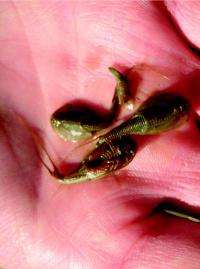This shows tadpole shrimp adults. Credit: © 2012 Entomological Society of America
Tadpole shrimp are pests of rice production systems in California and have recently been found impacting Missouri and Arkansas rice fields. The shrimp feed on rice seedlings and uproot them during foraging, and their foraging behavior causes water to become muddy, which reduces light penetration to submerged seedlings and delays the development of the rice plant.
In "Review of a New Pest of Rice, Tadpole Shrimp (Notostraca: Triopsidae), in the Midsouthern United States and a Winter Scouting Method of Rice Fields for Preplanting Detection," a new open-access article appearing in the Journal of Integrated Pest Management, the authors provide information on the life cycle of tadpole shrimp, describe a new method for scouting for tadpole shrimp in rice fields, and provide scouting results and management implications.
In the article, the authors discuss the tadpole shrimp's biology, life cycle, and distribution range, as well as options for controlling it. The authors also note that after the rice seedling stage, tadpole shrimp can be beneficial because they also eat weed seedlings and small insects.
More information: The full article is available for free at tinyurl.com/cjqwd4r
Provided by Entomological Society of America




















